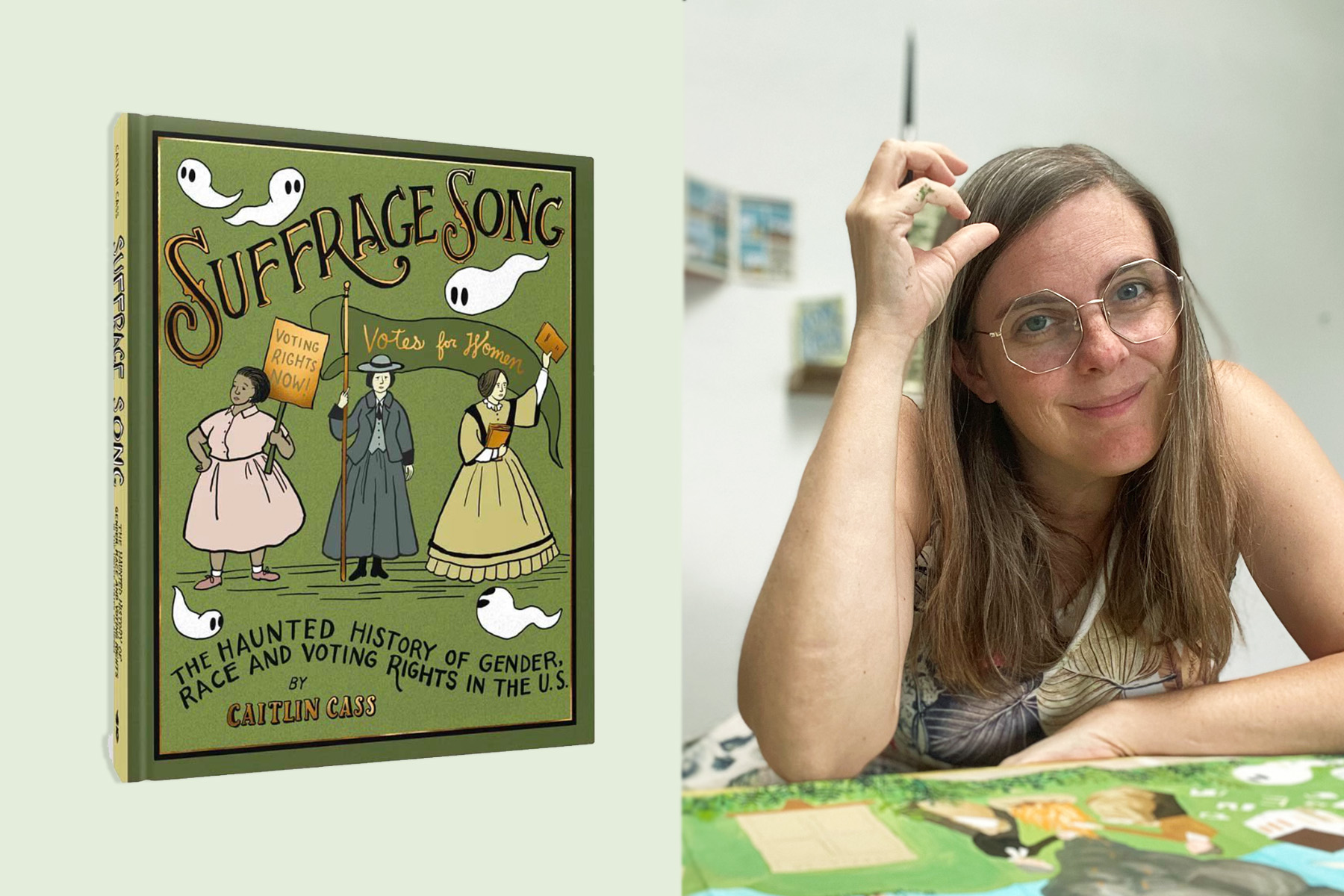When cartoonist Caitlin Cass started drawing a history of the women’s suffrage movement — a project that began in 2019 and eventually turned into her new nonfiction graphic book, “Suffrage Song: The Haunted History of Gender, Race and Voting Rights in the U.S.” — she felt the need to acknowledge her “deep and growing anxiety” about White women in this history.
Cass was haunted by the complicated stories of these White suffragettes, who fought for their right to vote but compromised away the voting rights of people of color for decades after the ratification of the 19th Amendment. The New Yorker contributing cartoonist explores this in her roughly 230-page book, out June 18, with illustrations that feature the imagery of ghosts following various suffrage organizers over the years. Cass does this not just through drawings but text fragments of old microfiche from newspaper clippings and foldouts, including a U.S. map of where women could vote ahead of ratification.
Cass covers the history of women’s suffrage in the United States from the 1848 Seneca Falls Convention to the Voting Rights Act of 1965, through the stories of organizers like Susan B. Anthony, Frances Ellen Watkins Harper, Alice Paul, Mary Church Terrell, and later Fannie Lou Hamer and Ella Baker. Cass describes her work as “a love letter to the histories that have already been written and are out there,” and integrates the songs suffragettes sang over the years — how they were shared among organizers, how they were contradictory at times, and how they brought comfort in times of hardship.
“I did not want to focus on only a few people because that seems like it misses one of the most important things about how these movements function. They require group effort. The cult of personality that is so prevalent in our culture is kind of antithetical to these movements and yet we continue to celebrate well-known individuals,” she said. “It’s easier to choose a figurehead than to celebrate all of the people who put in the work at once. I really wanted to try to celebrate them all.”
This interview has been edited for length and clarity.
The 19th: How did the idea for a graphic nonfiction book about women’s suffrage come together?
Caitlin Cass: It came together in part, I think, because I was teaching at an all-girls school in Buffalo, New York, where I used to live. And I had been mostly making comics about dead White guys and sort of failure throughout history. So sort of very much poking fun at just the history of Western thought and how I felt like it hadn’t really gotten us very far. But I think being in that all-women and nonbinary kind of environment, it really made me feel a new need to focus on this history that I just hadn’t really learned as much in school.
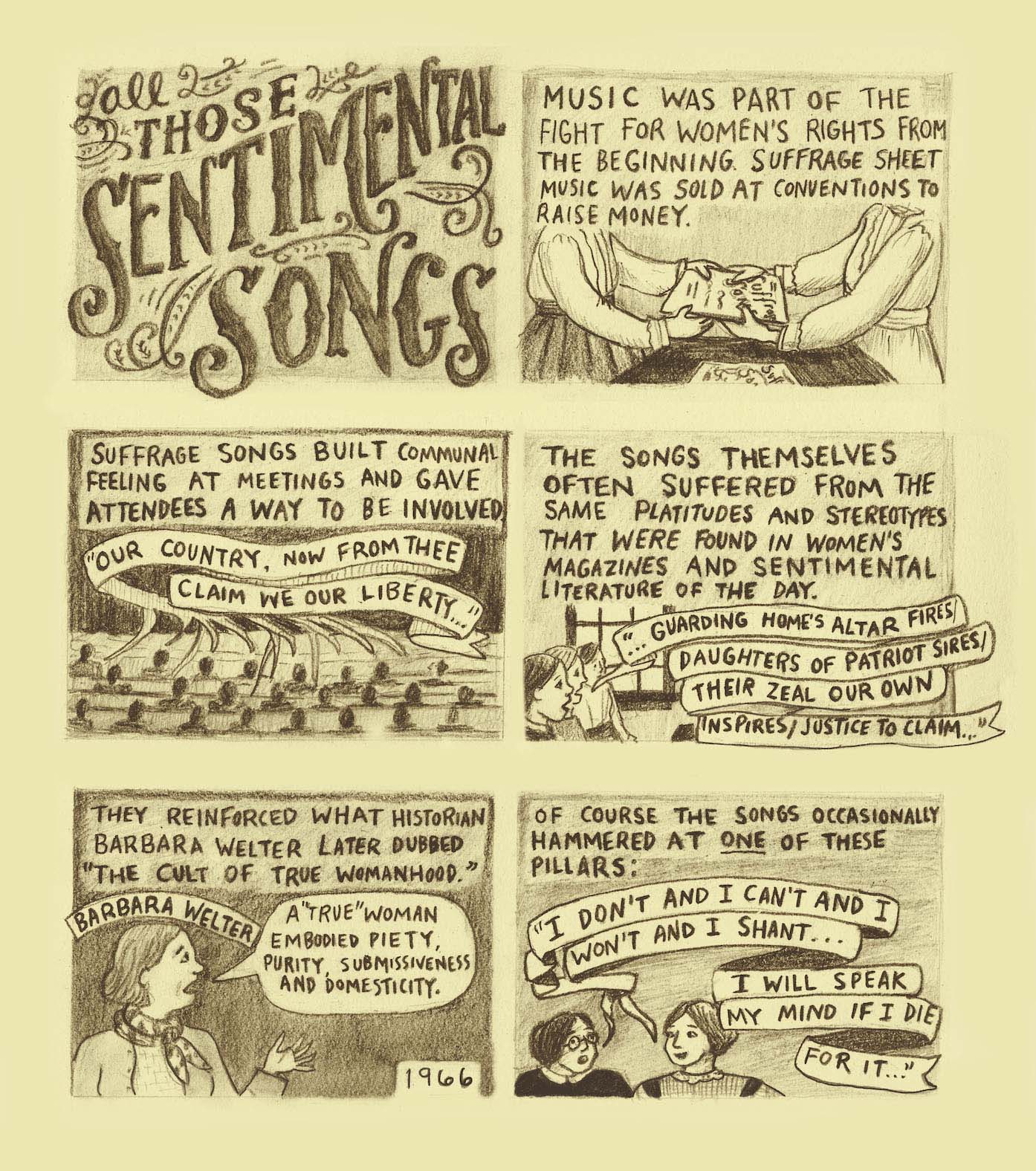
Why do you highlight songs sung by suffrage organizers? So much so that it’s the title of the book?
Cass: Songs sort of were the thing that created that communal feeling at a lot of the suffrage events. I was interested in the way that they sort of trivialize the ideas behind the movement and sometimes lean into stereotypes at the same time as they move the movement forward and create that communal feeling that I think is super necessary. Just this notion of this flawed thing that allows us to communicate became a larger metaphor for, I think, trying to tell any kind of history, or also just like trying to move forward in a movement, and as hard as you try, there’s always going to be something that could be improved or some mistake, and I felt like the songs kind of embodied that for me.
There’s a lot of little details, like how Susan B. Anthony was sensitive about a lazy eye and how it might impact her work, and also that audiences hearing about women’s rights were sometimes distracted by women organizers who wore pants instead of dresses. How did you decide what details to keep and which to cut?
Cass: It was largely my own interest and what I found fascinating, and the ways that sort of sat with the other stories that I was trying to tell. But certainly, the themes are kind of narrowed around what gets left out of history, what sacrifices women had to make in order to achieve their goals, when those sacrifices were racist and when they were maybe more just sort of pragmatic, and trying to explore those areas. So basically, kind of leaning into the things that made me uncomfortable and that I wanted to learn more about.
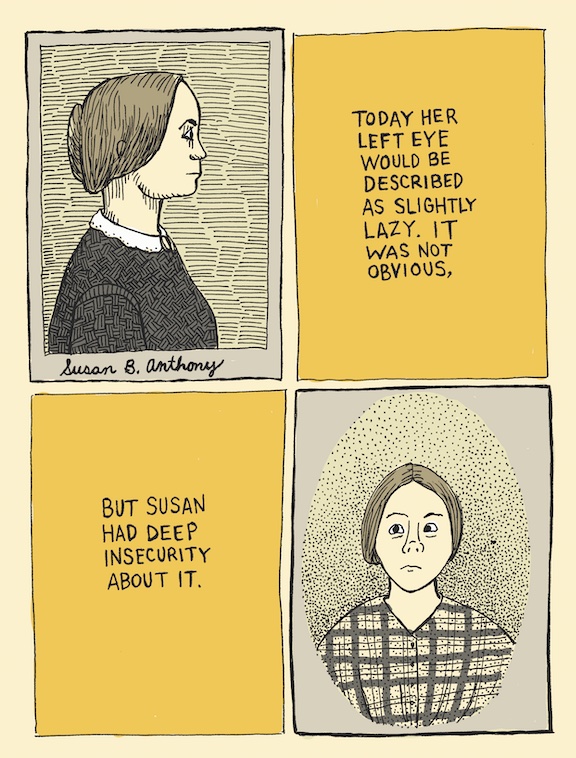
You include the names of so many women organizers who played not just big roles, but small roles on the road to suffrage. Some of these stories have been actively lost to history. How did you decide which of those voices to sort of elevate?
Cass: Well, toward the end of the book, where I focus on the Civil Rights Movement, some of the most prominent characters are Fannie Lou Hamer and Ella Baker. I chose these women because they come from very different socioeconomic backgrounds and they were both leaders in the movement in different ways. Ella Baker worked to empower students to organize across the South and help communities help themselves. Ella Baker was also involved in the Mississippi Freedom Democratic Party and worked with Fannie Lou Hamer. I had to include Fannie Lou Hamer because her testimony at the DNC convention is one of the most powerful speeches of the Civil Rights Movement.
Of course it was also very important to me to include Frances Ellen Watkins Harper and Sojourner Truth to show that Black women were working for voting rights all the way back in the mid to late 1800s. And then Mary Church Terrell and Mary Brunett Talbert were important to include because of all the organization they did at the turn of the century. Mary Church Terrell also stood up to Alice Paul for not advocating for Black women who weren’t allowed to vote after the amendment was passed. And of course Zitkála-Šá had to be included because I think it’s really fascinating how complicated her relationship was to voting as a Native woman.
It was really important to me to show that voting rights were fought for by many people from all over the country through multiple generations. I did not want to focus on only a few people because that seems like it misses one of the most important things about how these movements function. They require group effort. The cult of personality that is so prevalent in our culture is kind of antithetical to these movements and yet we continue to celebrate well-known individuals. It’s easier to choose a figurehead than to celebrate all of the people who put in the work at once. I really wanted to try to celebrate them all.
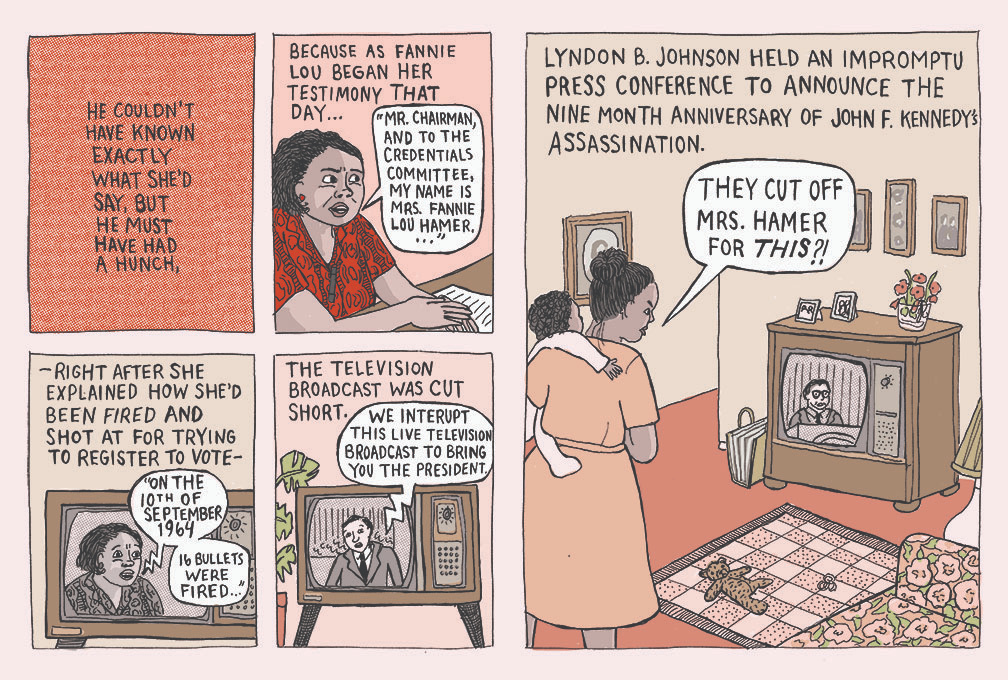
There’s this memorable section in the book where readers can pull out pages. There’s several of those pages, but here readers can pull out a page that shows smoke and flames from when Susan B. Anthony decided to burn archival letters that are now lost to history. Then there’s a map where we see the suffrage movement at a certain point politically before 1920. Why did you decide to use pullouts as a narrative device?
Cass: I grew up loving books that had those when I was a little kid. I just love the way that it creates a different kind of engagement with the book. I’m often also making books at the same time as I’m making gallery exhibitions. So it was sort of like I made these archives first, or these objects first, almost to assemble it like an archive and then piece it together that way. The book has a progression, but it also has this fragmented quality, and having these moments where you actually have to physically interact and engage, I feel like it just brings new imagination and life to the stories because you’re discovering it for yourself. It feels kind of like you’re piecing it all together.
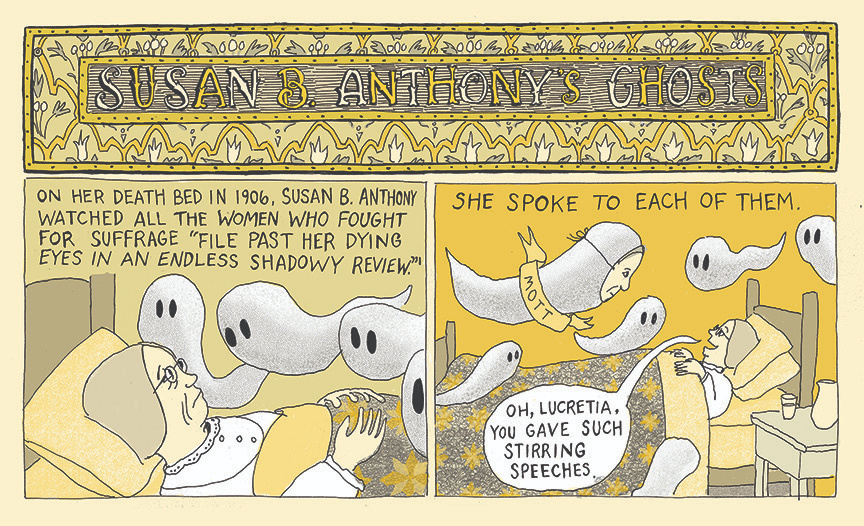
Ghosts, specifically the ghosts of past organizers and the imagery of them haunting suffrage organizers, are this major character in the book. How did this theme come to you?
Cass: I just think it’s sort of in the culture right now. It’s certainly language that’s used by Isabel Wilkerson in her book “Caste.” But initially, it came to me because of the connection to seances and the women’s rights movement. So the first story that had ghosts in it that I made, was that story of Elizabeth Cady Stanton writing the Declaration of Sentiments on a seance table. Basically it was taboo for women to speak in public in the mid 1800s in the United States, but it wasn’t if you were channeling dead people, and specifically dead White men. So it was a place where a lot of early women’s rights activists got the courage to start speaking publicly. I think that that was really interesting to me. So when I had first told that story about suffrage and spiritualism, it made me realize that maybe the ghosts could help me figure out how to tell the rest of this story, if they appeared. A lot of my work has a weird, sort of magical real life kind of twist at some point in it. So it’s like telling real histories, but there’s something that’s a little strange, with the hope of bringing the viewer to a point where they’re going to question what they’re seeing a little bit, and maybe engage with it to try to decipher fact from fiction more. Because I think it’s so important when you’re learning about any history.
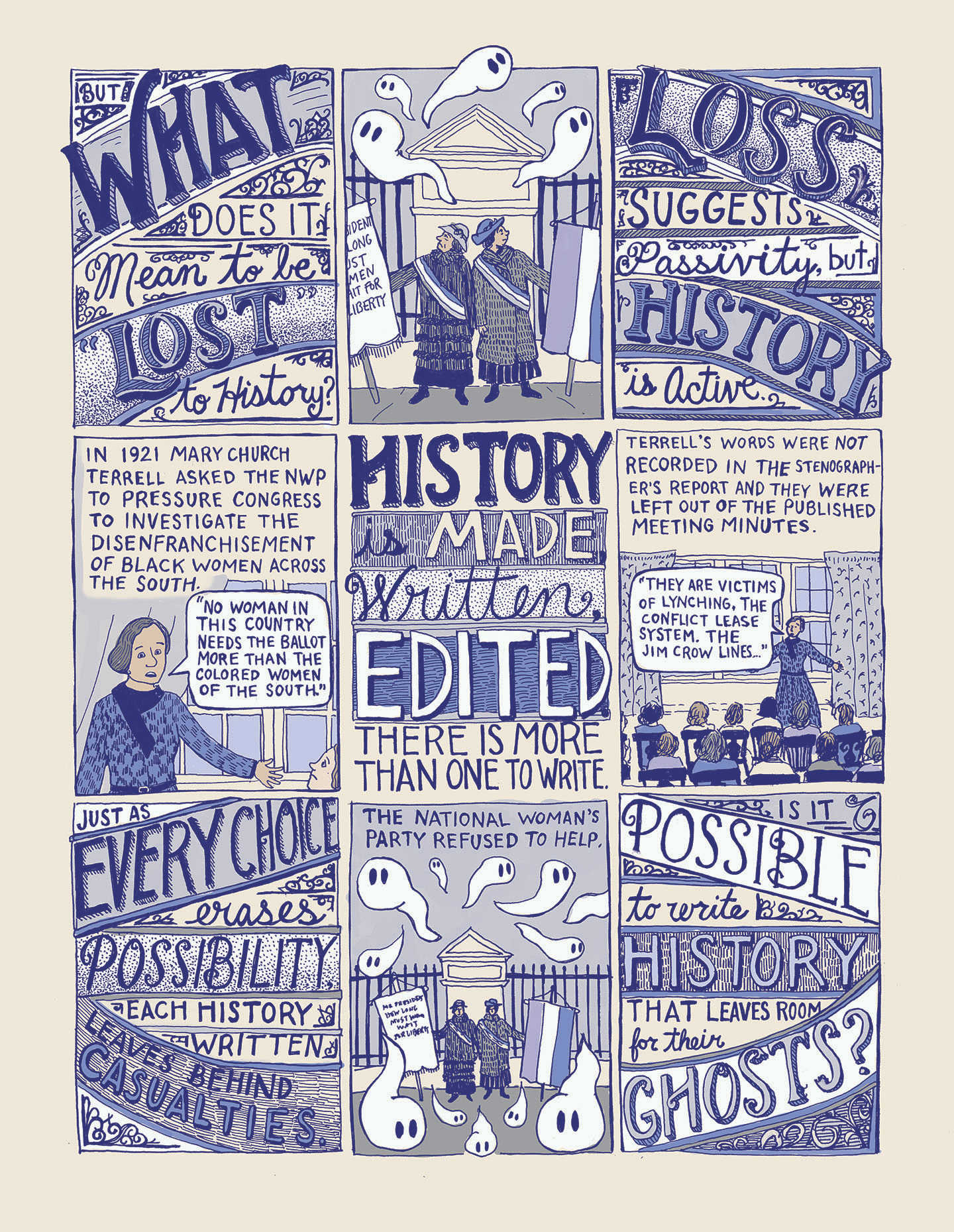
You also highlight how Black women in particular were committed to universal suffrage, while some White women made sort of political concessions that kept non-White women from access to the ballot for a lot longer after 1920. What are the takeaways for people reading about this in 2024? There’s been a lot more coverage in the last few years around the realities of that history. But what do you want people to take away from White women’s choices and the work toward universal suffrage?
Cass: I think the biggest thing is just just how interconnected the struggles of all disenfranchised groups are. There’s that Frances Ellen Watkins Harper quote that says that best — we’re all bound up together. And that choice kind of echoed into the future and affected everybody’s rights. Just thinking about what that means to get what you need politically, but then also as a result, have that affect other people negatively. Just trying to also realize that some of these things ensure that it was the only way forward, but like, what would it mean to have this radical imagination, to imagine a world that actually was more equitable? So I think just getting folks to think harder and look closer about histories and how they get written, is the main goal. And certainly, I think that’s super relevant today, with the ongoing threats to voting rights, ongoing issues with abortion and all of that.
The 19th has a relationship with Bookshop.org. If you make a purchase through the Bookshop links on our site, we may earn an affiliate commission.
